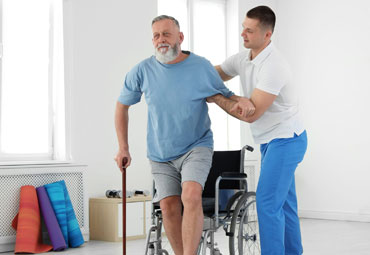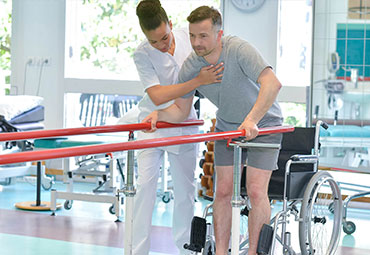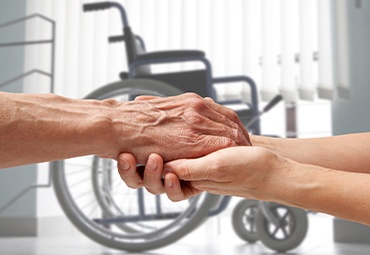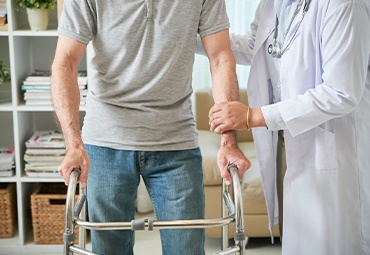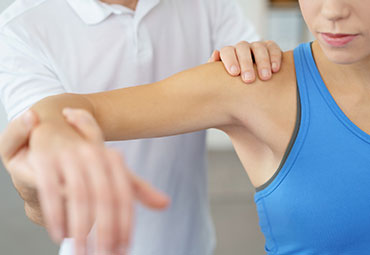
Hemiplegia (sometimes called hemiparesis) is a condition, caused by a brain injury or stroke, that results in a varying degree of weakness, stiffness (spasticity) and lack of control in one side of the body. After a stroke, it’s common to experience weakness or paralysis on one side of the body (left sided hemiplegia or right sided hemiplegia). This will depend upon which side of the brain your stroke occurred.
Right Side paralysis or weakness is caused by an injury to the left side of the brain, where the areas that handle language and memory are. Left Side paralysis or weakness is caused by an injury to the right side of the brain, which contains the areas that control facial recognition and nonverbal behavior.
Hemiplegia And Hemiparesis
Hemiplegia and hemiparesis sound very similar. In fact, both derive from “hemi,” a Greek word that means half. They do have distinct differences. Let’s take a look at how each condition affects the brain and body.
Hemiplegia
Hemiplegia is defined as the paralysis of muscles on one side of the body, contralateral to the side of the brain in which the CVA occurred [1]. Simply put, Hemiplegia is a paralysis that affects one side of the body. It’s often diagnosed as either the right hemiplegia or left hemiplegia, depending on which side of the body is affected. Generally, injury to the left side of the brain will cause a right hemiplegia and injury to the right side a left hemiplegia.
Effects of Hemiplegia
Hemiplegia often results into following among patients:
- Muscle spasticity (weakness in the muscles)
- Muscle atrophy (loss of muscle strength)
- Uncontrolled Seizures
- Body pain
Hemiparesis
Hemiparesis occurs when one side of the body is weakened, and it typically impacts your limbs and facial muscles. It affects about 8 out of every 10 stroke survivors. Patients may experience limited movement in their arms, hands, legs, or facial muscles, which can lead to increased difficulty performing everyday activities.
Effects of Hemiparesis
Experiencing a one-sided weakness in your arms, hands, face, chest, legs, or feet due to hemiparesis, may cause the patient to experience the following:
- Difficulty walking
- Loss of balance
- Difficulty grasping objects
- Lack of coordination
- Decrease in movement precision along with loss of spatial recognition
- Muscle weakness
Causes of Hemiplegia
What causes hemiplegia?
Muscle movement is controlled by signals sent to the body by the brain and spinal cord. When there is damage to the brain or spine, the signals are not able to direct the muscles to move, resulting in paralysis.
The most common cause of hemiplegia is a stroke (when a bleed or blood clot damages part of the brain)
Other causes of hemiplegia include the following:
- Spinal cord injury
- Brain tumor
- Cerebral palsy
- Broken neck
- Multiple sclerosis
- Autoimmune diseases
- Bell’s palsy
- Polio
- Muscular Dystrophy
- Spina bifida
- Brachial plexus injury
Are there other problems associated with Hemiplegia?
Apart from the effects of hemiplegia as discussed above, there are a few common complications associated with hemiplegia. These occur as a result of the weakness. Sometimes, these problems are not noticeable right away and may develop over the months after hemiplegia.
Some of the complications of hemiplegia include:
- Bladder problems- incontinence and/or urinary retention
- Bowel control problems
- Pain
- Deep vein thrombosis (DVT)
- Autonomic dysreflexia
- Depression
- Respiratory difficulties
- Heart disease
- Sepsis
- Pressure wounds
- Muscle spasticity
- Muscle atrophy
Treatment and rehabilitation for hemiplegia under a qualified and experienced team such that of ReAble ensures that the patient and caregiver both are aware of these complications. They make sure that proper prevention strategies are adopted within the rehabilitation programme to minimise these. Make sure you support your rehab team.
Rehabilitation of Hemiplegia
Treating Hemiplegia and Hemiparesis
Although hemiplegia and hemiparesis are serious handicaps, carefully planned rehabilitation can help a lot to minimise its effects and improve movement and recovery.
At ReAble we believe it is important for multiple specialties (physiotherapists, occupational therapists, speech and swallow therapist, nutritionist and others) to work together. The team is led by a programme lead who ensures that all team members and family members are on the same page.Here are some of the techniques that ReAble Neuro Rehabilitation experts use to aid in recovery of hemiplegic patients.
- Range-of-Motion Exercises to prevent muscle stiffness and contractures
- Flexibility Training to improve blood circulation, posture and movement
- Electrical Stimulation to improve range of motion and sometimes reduce pain
- Motor Imagery (MI), this mental practice has been shown to improve arm movement in patients with hemiparesis [2]
- Chest physiotherapy to improve respiratory function
- Mobility aids including use of wheelchairs as well as braces, canes, and walkers to help you lead an independent, active life even if you have hemiparesis or hemiplegia.
- Assistive technology to use voice-activated devices, computers, telephones and lighting systems if available to the patient
- Adaptive equipment, use of specially designed devices that can help in practical day to day activities.
Learning how to live with hemiplegia is important for the hemiplegic and for those around them. ReAble works towards helping the patient adapt to their new situation and support their recovery in the best possible manner. Call us now or connect with us by filling the form below and we will be happy to help!
Hemiplegia or Hemiparesis? ReAble can Help
Scientific References:
[1] Physical Management in Neurological Rehabilitation (Second Edition), 2004, G.Baer B.Durward; https://www.sciencedirect.com/science/article/pii/B9780723432852500103
[2] Motor imagery training improves precision of an upper limb movement in patients with hemiparesis; Luzia Grabherr 1 2, Corinne Jola 3, Gilberto Berra 4, Robert Theiler 4, Fred W Mast 1; PMID: 25882199 DOI: 10.3233/NRE-151203
- Date:8 Jul, 2021
- Posted By:ReAble
- Categories:Brain Injury
- Tags: hemiparesis, Hemiplegia, left side paralysis, right side paralysis






